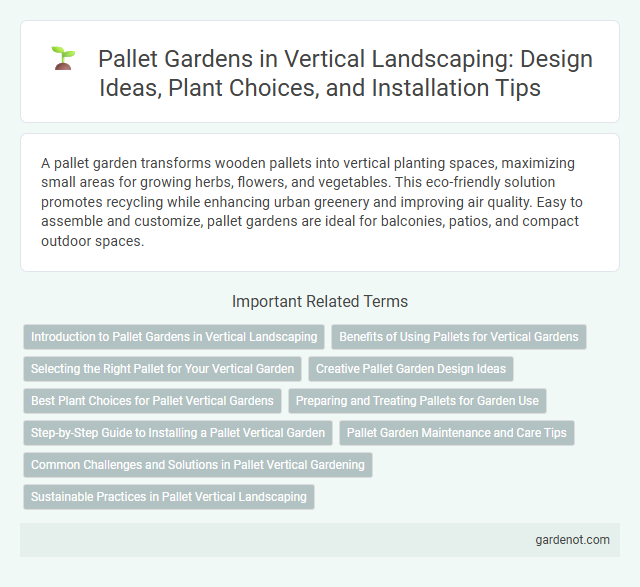A pallet garden transforms wooden pallets into vertical planting spaces, maximizing small areas for growing herbs, flowers, and vegetables. This eco-friendly solution promotes recycling while enhancing urban greenery and improving air quality. Easy to assemble and customize, pallet gardens are ideal for balconies, patios, and compact outdoor spaces.
Introduction to Pallet Gardens in Vertical Landscaping
Pallet gardens offer an innovative solution for vertical landscaping by repurposing wooden pallets into sustainable planting structures. These gardens maximize limited space, allowing for efficient growth of herbs, flowers, and vegetables on walls or fences. Lightweight and cost-effective, pallet gardens promote urban gardening and contribute to greener living environments.
Benefits of Using Pallets for Vertical Gardens
Pallet gardens maximize urban space by enabling vertical planting, making them ideal for small balconies and compact yards. Using pallets for vertical gardens promotes sustainability through repurposing wood, reducing waste while providing sturdy support for climbing plants and herbs. Their affordability and ease of customization allow gardeners to create efficient, space-saving green walls that improve air quality and boost biodiversity.
Selecting the Right Pallet for Your Vertical Garden
Choosing the right pallet for your vertical garden involves selecting untreated, chemical-free wood to ensure plant safety and environmental health. Look for sturdy pallets with intact slats that provide adequate support and drainage for various plants. Opting for pallets labeled as heat-treated (HT) avoids harmful chemicals and enhances durability in outdoor garden settings.
Creative Pallet Garden Design Ideas
Creative pallet garden design ideas transform wooden pallets into vertical garden structures that maximize space and add rustic charm to small areas. Incorporating diverse plants such as herbs, succulents, and flowers, these designs use the pallet's slats as mini planter boxes for efficient soil drainage and root growth. Customizing pallets with paint, lighting, and decorative elements enhances aesthetic appeal while promoting sustainable gardening practices in urban environments.
Best Plant Choices for Pallet Vertical Gardens
Succulents such as echeveria and sedum thrive in pallet gardens due to their low water requirements and compact growth. Herb varieties like basil, thyme, and mint are also ideal for vertical planting, supporting quick harvesting and aromatic benefits. Ferns and small flowering plants like petunias provide lush greenery and vibrant color, enhancing the visual appeal of pallet vertical gardens.
Preparing and Treating Pallets for Garden Use
Preparing and treating pallets for a vertical garden involves thoroughly cleaning the wood to remove dirt and potential contaminants. Sanding the pallet surfaces ensures smoothness, preventing splinters and improving paint or sealant adherence. Applying a non-toxic, weather-resistant sealant protects the wood from moisture and pests, extending the lifespan of the vertical garden structure.
Step-by-Step Guide to Installing a Pallet Vertical Garden
Start by selecting a sturdy wooden pallet and thoroughly cleaning it to remove dirt and debris. Secure landscaping fabric or a plastic liner inside the pallet to hold soil and prevent water leakage, then fill it with high-quality potting mix. Position the pallet vertically against a wall or fence, plant your chosen greenery into the pallet's slats, and water consistently to encourage healthy growth in your vertical pallet garden.
Pallet Garden Maintenance and Care Tips
Frequent watering and ensuring proper drainage are essential to maintaining a healthy pallet garden, preventing root rot and nutrient deficiencies. Regular pruning of plants encourages growth and keeps the garden looking tidy while inspecting for pests helps avoid infestations that can damage the vegetation. Applying a balanced fertilizer every few weeks supports robust plant development and vibrant foliage in vertical pallet gardens.
Common Challenges and Solutions in Pallet Vertical Gardening
Pallet vertical gardening often faces challenges such as limited soil depth, inadequate drainage, and exposure to harsh weather conditions that can stress plants. Selecting drought-tolerant species, using well-draining soil mixtures, and applying protective sealants to wood pallets help mitigate these issues. Regular maintenance, including checking for pests and rotating plants seasonally, ensures a thriving pallet garden with sustained growth.
Sustainable Practices in Pallet Vertical Landscaping
Pallet gardens promote sustainable practices by repurposing wooden pallets, reducing waste and lowering the demand for new materials. Utilizing vertical space efficiently, these gardens conserve water through controlled irrigation systems and minimize soil erosion compared to traditional landscaping. Incorporating native plants further enhances biodiversity and supports local ecosystems within pallet vertical landscapes.
Pallet garden Infographic

 gardenot.com
gardenot.com